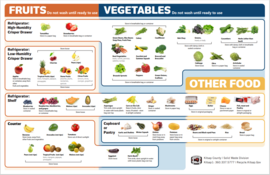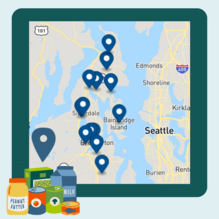|
|
It's National Food Waste Prevention Week! We're joining statewide efforts to cut food waste in half by 2030, and we need your help to get there.
Food waste costs the average household about $1,500 a year. And it’s not just your wallet that pays the price. Food waste also has a big impact on the environment. When we send food to the landfill, it breaks down to create methane—a harmful greenhouse gas. You can be part of the solution with our food waste reductions tips.
|
|
Be a savvy shopper
Planning your meals will not only reduce food waste but also help stretch your grocery budget.
Plan before you cook
Start by checking what food you already have and create an "eat soon" area in your fridge and pantry for items at risk of spoiling. Then, plan meals using these items with our meal planning guide.
Cook what you have
If your items are starting to spoil, get creative with recipes. From turning mushy tomatoes into tomato gravy or brown bananas into banana bread—there are so many possibilities!

|
|
Store and preserve food properly
Keep it fresh
Storing foods the right way keeps them fresh for as long as possible. Some fruits and veggies love a cool dark home, while some prefer to be stored on the counter. Learn how to maximize freshness with our food storage guide.
Understand date labels on food
Date labels on food are confusing and create unnecessary food waste. Except for infant formula, food that is stored properly may still be safe to eat if the date passes and until spoilage is evident. When in doubt, toss the item in the compost or garbage.
|
|
 Food storage guide
The shelf life of your food can depend on where and how you store it.
|
Food storage, cooking, and safety
U.S. Department of Agriculture's FoodKeeper App helps you maximize freshness and quality of your food.
|
|
Help others, donate

When you donate food, it goes to people who need it instead of the landfill. You can donate many non-perishable and to local food banks, pantries, and shelters.
What to donate
- Shelf-stable food
- Fresh produce
- Ask your food pantry what items they need.
- Foods prepared by licensed establishments, processors, and donor kitchens.
For more information on donating food safely, visit UseFoodWell.org.
|

|
|
Compost your food scraps
Food scraps in the landfill quickly break down to create methane – a powerful greenhouse gas. When methane is released into the atmosphere, it affects the earth’s temperature and climate system (EPA, 2021). EPA estimates that wasted food creates 58% of methane emissions from landfills. We can reduce our methane emissions by turning food scraps into a nutrient-rich resource.
Choose your method
There's a composting option for everyone.
-
Worm composting is great for limited space and can be done indoors. You can make a worm bin from inexpensive materials or purchase a pre-made worm bin kit. Start your worm composting journey with our Worm Bin Quick Start Guide.
-
Backyard composting is perfect for those who have a little more room. Using an open or a fully enclosed compost bin, you can make compost in your own backyard.
-
Curbside composting is an excellent choice for busy households. Most homes in Kitsap are eligible for curbside pickup of food scraps and yard debris. Contact your service provider to set up the service.
Keep your compost clean
When trash makes it into the compost bin, it can end up in the compost that is returned to our lawns, gardens, and farms. Keep your curbside compost clean with our Curbside Compost Guide.
|
|
 *Information and links provided do not constitute an endorsement of any kind from Kitsap County nor does Kitsap County verify information provided by or in third-party links. Kitsap County makes no representation or warranty concerning the content, accuracy, currency, completeness or quality of the information. Your use of the links provided is your agreement to assume all responsibility for the use thereof and to hold Kitsap County harmless for any damage or loss arising out of such use.
|
|
|
|
